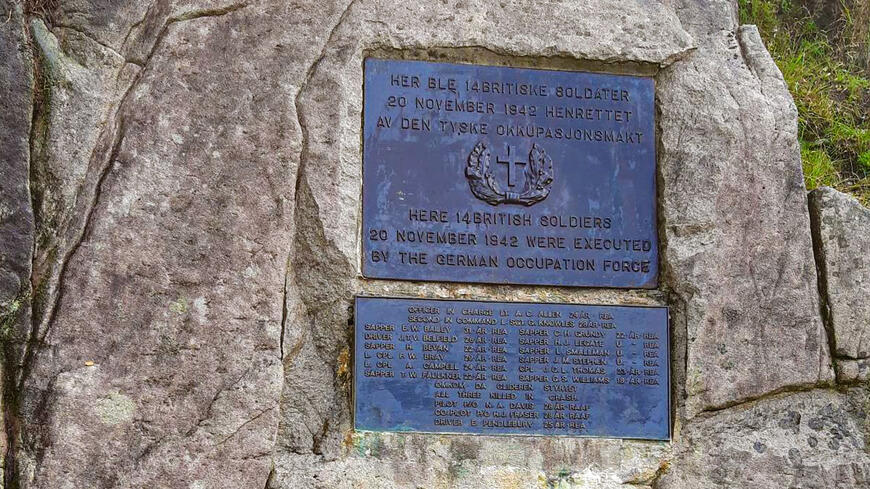More on Operation Freshman
Halifax B crash site Halifax B burial site Glider B crash site Execution site Memorial camp, Slettebø
Memorial camp
It became of the utmost importance for the British to destroy this production, and an attack by airborne troops was chosen as the mode of attack. The task was assigned to the 1st Airborne Division of the Royal Engineers. The men who took part in the operation were all volunteers, even though they did not know what the assignment was or where it would take place. After much discussion it was decided to land the attack force by glider and, due to the importance of the task and the risky nature of the operation, it was decided that two gliders, each carrying 1 officer, 1 sergeant, 13 engineer soldiers and 2 pilots, i.e., a total force of 34 men, would be used, so that if a problem occurred with one glider, the other would be able to complete the assignment. The soldiers and aircrew then engaged in a period of specialist training and practice for the mission.
The departure of the first Halifax tug aircraft and Horsa glider combination (Combination A) took place during the early evening of the 19th November 1942 from Skitten Airfield in the far northeast of Scotland. However, it is the second combination (Combination B) which left 20 minutes later, that we will focus on here, as both tug and glider crashed in the mountains nearby.
Tragedy in the Helleland and Egersund areas
The aircraft navigated successfully to the designated landing area near Vemork in Eastern Norway, but had to turn back without releasing the gliders as, due to low clouds, visibility was too poor for them to locate the marked landing strip. On the return journey, Combination B lost altitude over the Helleland area, and after the tow-rope broke, the glider crash-landed northeast of Benkjafjellet on heathland belonging to Hovland farm. Three of the crew, including both glider pilots, were killed and three others seriously injured in the crash. The 11 remaining soldiers were more or less unharmed. The tug plane continued flying at low altitude and crashed into a mountain, Hestafjellet, on the other side of the valley. All seven crew of the Halifax were killed instantly. Meanwhile, two soldiers from the glider managed to contact local Norwegians to explain the situation and to say that they urgently needed medical assistance. Inevitably, the Germans, including the local Wehrmacht unit and the Gestapo from Stavanger became aware of the incident and between 10:00 and 11:00 on November 20, the British soldiers who had been taken into custody were transported to the German army camp at Slettebø, near Egersund.
Later that day, two members of the German security police, SD, arrived, and the British soldiers were interrogated and photographed. This took place in an upstairs room of the military hospital. Following this, at around 16:00 hours, the men were lined up individually about 80 metres apart, along “Burmaveien” (The Burma Road) which led northwards from the main camp. Each man was guarded by two German soldiers. They were then led one by one to a designated site and executed by firing squad. After each execution, the firing squad concealed themselves behind a small cement building in the immediate vicinity – reappearing each time a new victim was brought into place. The dead bodies were then thrown into a shallow excavated area in the nearby marsh. The executions took place about 100 meters in a northerly direction from the Freshman memorial plaque.
The Hitler order
The Germans' actions have to be seen in light of the infamous “Hitler Order” (Führerbefehl), which had been issued on October 18, 1942. It stated that anyone engaged in sabotage missions (commando-style raids) in German-occupied countries that German troops encountered in battle, should be completely annihilated. This outcome was independent of whether the enemy appeared in uniform or not, or was willing to surrender. If such sabotage groups initially fell into the hands of the police, they were to be immediately handed over to the Gestapo. To detain anyone engaged in sabotage, actions as an ordinary prisoner of war was strictly forbidden. In all cases where people engaged in such actions were encountered, compliance with the “Hitler Order, was to be reported directly to the High Command in Berlin.
The “Hitler Order” was sent to all senior German commanders, including the Commander-in-Chief in Norway, General Nikolaus von Falkenhorst who passed it on to his subordinate commanders. This meant that the acting Wehrmacht commander in Slettebø Camp was aware of the order, as was his superior in Stavanger. After the war, von Falkenhorst was tried for war crimes and his responsibility in connection with the “Hitler Order”, which had terrible consequences for Operation Freshman, was among the most serious charges he faced. Von Falkenhorst was found guilty and sentenced to death, but the sentence was later commuted to 20 years in prison.
The last word
Following the executions, the Germans tried to erase all traces of what had happened. That same night, they secretly buried the bodies in the sand dunes by Ogna (Brusand), but a local Norwegian observed what they were doing. After the liberation, the bodies were located, exhumed and reburied with full military honours at Eiganes cemetery in Stavanger. The seven aircrew from the Halifax tug aircraft were buried at Helleland cemetery. Post-war, there have been three major memorial services at Slettebø in connection with this tragedy. In 1957, the first commemorative plaque was unveiled, then in 1990, a second plaque bearing the names of the victims was set in place. In 1995, another memorial service was held in connection with the anniversary of the liberation of Norway. Our allies and their commitment to the cause of freedom will never be forgotten.
Original Norwegian text by Jostein Berglyd. English translation and minor modifications by Bruce A. Tocher.

